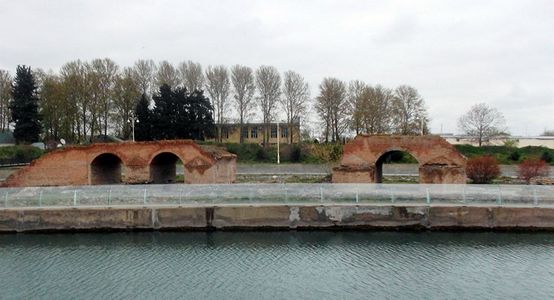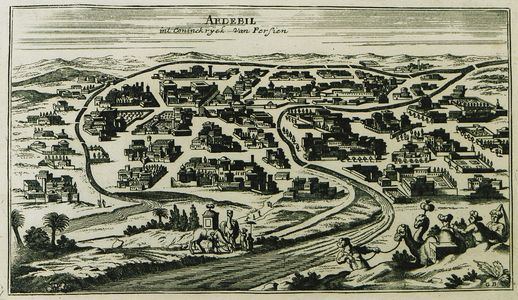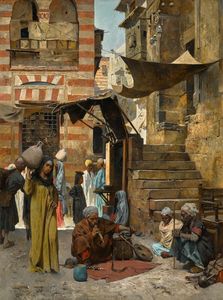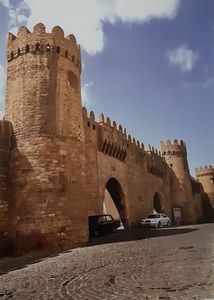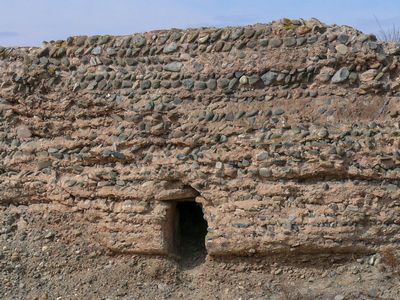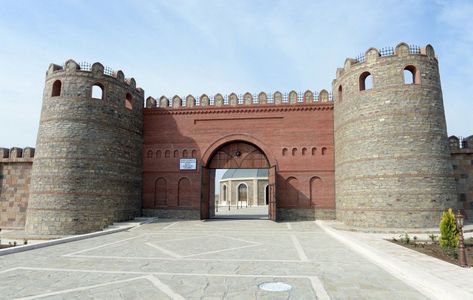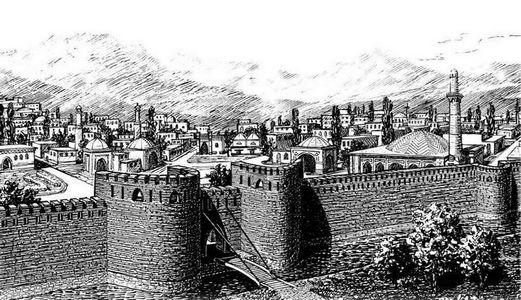Establishment of the Republic of Azerbaijan
In the IX-XIII centuries, one of the most developed industries in Azerbaijan was silkworm breeding. In Shaki, Shirvan, Barda, and other districts, silkworm breeding became the main occupation of the population.
One of the main areas of agriculture was cattle breeding. Pasture-winter hut cattle-breeding took the main place in Azerbaijan. Cattlemen kept cattle, sheep, camels, and horses.URBAN LIFE AND TRADE
Economic relations within the country had expanded and trade relations with foreign countries had recovered. New cities have sprung up, such as art and trade centers.
Arab authors named about 50 cities in Azerbaijan, including Barda, Ganja, Ardabil, Tabriz, Bakuye (Baku), Sheki, Neshave (Nakhchivan), Shamakhi, Beylagan, Maragha, Darband, and others. When speaking about Azerbaijani cities of the X century, Barda is especially mentioned. Al-Istakhri wrote: "There is no city between Iraq and Khorasan that is bigger, more productive and better positioned than Barda after Rey and Isfahan." Ibn Havgal added to his successor's words, "After Rey and Isfahan, there is no bigger city than it, with farms, markets, hotels, caravanserais, buildings, property and trade." He said that many products were made of silk in Barda and silk was exported abroad. Bab al-Abvab – Darband, considered by al-Istakhri to be "larger than Ardabil," was the country's largest port city. Darband was considered the only textile center in the South Caucasus. Various clothes made by Darband artisans from linen were sent to foreign countries for sale. The Darband market was popular throughout the East like Kurkiy market of Barda and Kulsura market of Ardabil. As in Barda, Ganja, Shamakhi and other large cities of Azerbaijan, a cleaning system installed from special tungs to discharge polluted water was created here. The city stood out for its cleanliness and culture. According to al-Muqaddasi, a sewage system was built in Darband in the X century to discharge polluted water.
Al-Istakhri, Ibn Havgal, and al-Muqaddasi al-Ardabili, among the Arab authors, considered Ardabil to be the "largest and main city of the South Azebaijan". In the 10th century in the south region, Ardabil was followed by Maragha and Urmia. After becoming the capital during the Ravvadis in the X century, Tabriz became one of the big cities in Azerbaijan. It was located at the junction of Azerbaijan's domestic trade and international caravan routes. Al-Muqaddasi noted that Tabriz is a superior city to Madinat as-Salam – Baghdad. The Arab traveler likened the city of Tabriz, which was "without limit of beauty," cheap in price, and abundant fruit, to "pure gold," and considered it "a rare chemistry, impregnable city". Carpets, satin, taffeta, and other silk fabrics woven by Tabriz artisans were sold in world markets. One of the main mints of the Eldiguzids was located in Tabriz. Yaqut al- Hamawi called Tabriz the most famous city of Azerbaijan.
In the IX-XI centuries, the economic importance of Baku also increased. The Arab traveler al-Masudi called Baku "the oil-producing land and coastal city of Shirvan." Speaking of Baku's oil fields, al-Masudi was skeptical that "there is no other place in the world where kerosene and other types of oil is produced." In the 11th and 13th centuries, oil and solt exports from Baku to Azerbaijani cities and neighboring countries expanded significantly.
The main occupations of the urban population in Azerbaijan were crafts and trade. In the cities, artisans of the same profession formed artisan associations (fraternities). Potters, tanners, painters, blacksmiths, gunsmiths, and others were united in separate fraternities.
In the XII - XIII centuries, agriculture, handicrafts, and trade flourished in the country. During the rule of the Eldiguzids, the role of Ganja, Nakhchivan, Beylagan, Tabriz, Shamakhi in the economic life of Azerbaijan increased significantly. Each of these cities had a population of tens of thousands and in some even more than 100,000. There is information in the sources about the population of several hundred thousand people in Ganja during the Eldiguzids period. Ganja was one of the great centers of silk-making and important pottery in Azerbaijan, raw silk, silk and cotton fabrics, etc. were exported to many countries of the world. Nakhchivan was a great center of crafts and trade.
During the Eldiguzids period, about 40,000 people lived in Beylagan. Weaving, painting, armaments, pottery, etc. in the city. developed more than thirty arts and professions. There were several markets in the city. One of the Eldeniz mints was located in Beylagan.
One of the important art and trade centers of Azerbaijan was the city of Shamakhi. About 100,000 people lived in Shamakhi. Shamakhi was one of the centers of silk production in Azerbaijan. Caravan routes from Derbent to Ganja and Barda, as well as to the southern regions of Azerbaijan passed through Shamakhi. Merchants from all over the world came here to buy Shirvan's raw silk and various delicate silk fabrics. Raw silk was exported to the cities of Western European countries (Italy and France, etc.)
During this period, shipping played an important role in the expansion of domestic economic relations. Ships were constantly sailing between the western and eastern shores of Lake Urmia. According to the sources, ships were moving in the part of the Kura River from Barda to the Caspian Sea. Azerbaijan's foreign sea trade was carried out through the Caspian Sea.
During this period, Azerbaijan had two large international markets. In Europe, such markets were called fairs. At certain times of the year, merchants from all over the world flocked to such markets. Azerbaijan's first international market was, the Al-Kurkiy market in Barda, " Arran's mother ". According to al-Istakhri, Ibn al- Havgal, and al-Muqaddasi, merchants from around the world trading in the al- Kurki market, which was about 1 square farsakh (6-7 square kilometers). This market was so popular among the people that the Sunday of the week was called "Al-Kurki Day". Azerbaijan's second-largest international market was the Kulsure (Gulsara) market, located on the Ardabil-Maragha trade route. Foreign traders who come to the Kulsure market, which opens at the beginning of each month, sell silk fabrics, gold-silver, copper products, perfumes, cattle, etc., woven in Azerbaijan, India, and other countries. According to Ibn Havgal, tens of thousands of sheep and lambs were simultaneously sold in this market.
According to Ibn Havgal, annual income of the Khunaj customs house, located on the trade route from Azerbaijan to Rey, was 100,000 dirhams. This income increased or decreased to 1 million dirhams a year. Surprised by such a large income, the Arab traveler noted that no other country in the world has such a thing. Although copper coins were used in circulation along with gold dinars and silver dirhams, in the 11th and 12th centuries copper coins were the main currency in circulation in connection with the silver crisis that engulfed the whole East, including Azerbaijan.
At the beginning of the XI-XIII centuries, the development of agriculture, handicrafts, and trade created favorable conditions for the expansion of commodity-money relations. During this period, some Azerbaijani rulers cut money in their names. Gold and silver coins were issued according to circulation.
Thus, at the beginning of the IX-XIII centuries, Azerbaijan's economy, farming, and urban life experienced a period of great growth and prosperity.Thus, the written sources confirmed by the results of archeological research shows that cities, crafts and trade began to develop in Azerbaijan after more than two centuries of economic stagnation in connection with Arab occupation, the Caspian marches, the protests of the local population against the Caliphate, and so on. Despite the various events that took place, in the twelfth century of our history, the level of urban life in Azerbaijan, in particular, reached the highest level in the entire history of the Middle Ages.
